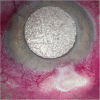Capnocytophaga canimorsus blebitis: case report and review of literature
- PMID: 33499831
- PMCID: PMC7839216
- DOI: 10.1186/s12886-021-01823-8
Capnocytophaga canimorsus blebitis: case report and review of literature
Abstract
Background: Capnocytophaga canimorsus is a facultative anaerobic, slow-growing, capnophilic, Gram-negative bacillus, that is commonly found in the microflora of canine and feline oral cavities. Capnocytophaga infections are an emerging zoonotic disease that can cause fatal systemic infections in immunocompromised individuals. Localized ocular Capnocytophaga infections, including keratitis, blepharitis, and endophthalmitis, can lead to severe eye threatening situations. To our knowledge, there is currently no documented case of Capnocytophaga canimorsus blebitis with bleb perforation after trabeculectomy.
Case presentation: Our case report and literature review features a novel case of Capnocytophaga blebitis that occurred after trabeculectomy, associated with close dog contact (i.e. face licking). The patient had underwent trabeculectomy 10 years prior and presented with conjunctival injection, perforated bleb, and hypotony. Overall, patient was medically treated subconjunctival vancomycin, gentamicin and moxifloxacin drops. Trabeculectomy revision was performed with good visual outcome. Bacterial cultures grew Capnocytophaga canimorsus.
Conclusions: We discuss the strategies for diagnosis, treatment, and common risk factors for ocular Capnocytophaga infections. At-risk patients with ocular infections should be asked about close contact with dogs and cats; and treated promptly with the proper antibiotic regimen.
Keywords: Bleb perforation; Bleb-associated infections; Blebitis; Capnocytophaga canimorsus; Case report; Trabeculectomy.
Conflict of interest statement
The authors declare that they have no competing interests.
Figures




References
-
- Blanche P, Bloch E, Sicard D. Capnocytophaga canimorsus in the oral flora of dogs and cats. J Inf Secur. 1998;36(1):134. - PubMed
Publication types
MeSH terms
Supplementary concepts
LinkOut - more resources
Full Text Sources
Other Literature Sources
Miscellaneous

